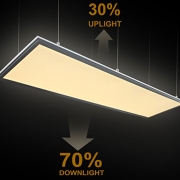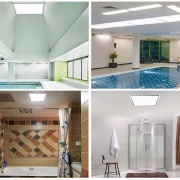What Is the Difference Between SMD and COB LED Lighting?
SMD means Surface Mounted Device and COB stands for Chip On Board. Light emitting diode or LED for short has become highly popular. The Surface Mounted Device (SMD) was initial presented in 2008. Whereas, the COB LED technology has been available since 2010 in Guangzhou at the Canton Fair.
These SMD chips are of various colors such as Blue, Green and Red which helps produce tinted lights. The COB LED lights are either ceramic or light weight aluminum.
What is an SMD LED Light?
SMD lights use SMT technology which places the LED chip onto a PCB. The PCB board is constructed in a flat item, rectangular-shaped, and is what one said as an SMD. One can see a tiny black point at the center of the SMD if you look carefully in an SMD LED, it is the LED chip. The rear side of it has two steel points (cathode as well as anode) which are made use of for soldering with the circuit for the light.
The 5050 SMD has three steel points as there are three chips inside. The SMD Led has different types, such as 5730, 5630, 5050, 3030, 3014 and also 2835. Each of these is called according to the measurements of the LED meaning it is based on the width and length. Prior to the COB was created, the SMD 5050 as well as 3528 was made use of.
What is a COB LED?
The COB LED uses the brand-new encapsulation innovation. As compared to the SMD 5050: 3 chips or the 3528: 1 chip, the COB LED has numerous chips on the same printing circuit board (PCB). The PCB gets on the substrate of the COB. The diode chips of the COB are ranged in series/ or parallel which depends upon the circuit. This substratum can either be ceramic or light weight aluminum. If you are searching for a much better thermal conductive efficiency, then the ceramic type is what you need as it will guarantee a much lower LED running temperature.
The COB LED has 2 metal link points, the cathode and anode. The COB has a better thermal conductivity as compared to the SMD, due to the fact that it mounts chips straight to the substrate that has a substantial cooling space. In order to have the COB dimension to be as little as possible, the circuit needs to be made to reduce the chip’s distance.
Verdict
COB LEDs are available in different forms which make it easier for them to be utilized for different fittings. Whereas, SMD lights can just be made use of for restricted fittings, there are lots of advantages of using COB LED lights such as far better thermal conductivity as well as lower manufacturing failing rates as a result of the patent layout.
Choosing between SMD and COB LED lamps relies on your requirements. Both of the lights are being utilized for various applications. When choosing in between the two lights, first know about which fixture is being used for. LED lights have changed the entire lights market.



